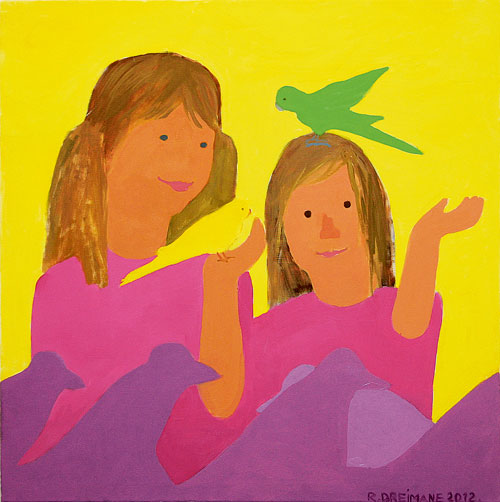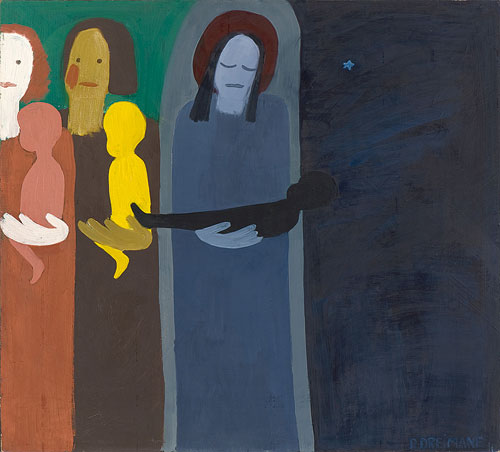|
|
| Holy icons for a private desert Pēteris Bankovskis, Art Critic Rudīte Dreimane. Paintings 12.04.–13.05.2012. Creative workshop of the Latvian National Museum of Art exhibition hall Arsenāls | |
| For a long time now I have ceased to be an avid attendee of exhibitions, and openings I skip entirely. For me, as for millions of others, as the years go by time becomes compressed and aimed towards a single clearly defined point. And much of what earlier seemed unquestionably important now appears to be a mere misunderstanding, an annoyance or a fleeting grimace from the world. The occasional activity of dabbling in reviewing exhibitions for newspapers also makes me smile: “OK, there was some exhibition or other, I wrote something and someone else scribbled something else; one artist was offended, another was happy, another wrote a complaint to the powers that be, yet another patted me on the back. So what?” | |
 Rudīte Dreimane. Birds. Oil on canvas. 140x140 cm. 2012 Photo: Daina Auziņa | |
| Such banal reflections crept upon me after reading the 24 April edition of the portal Satori, where Vilnis Vējš attacked Marta Krivade over a single unguarded, subjective aside, and in the verbal battle each attracted a whole host of commenting supporters. “Dear people,” I thought, “what will become of the fruit of all your “passions” in a week’s time! Surely it will be gone without a trace.” Especially on a “portal...” On seeing or hearing this word, the present-day person may imagine a science fiction device which acts as a kind of gateway for the heroes to enter into other dimensions of space, time or consciousness. That day I had braced myself to write something about Rudīte Dreimane’s exhibition. Her paintings had caught my attention the moment I first saw them, some 24 or 25 years ago. They reminded me of applique: robust forms, uniformly coloured fields, no perspective, spatial illusions, “chiaroscuro” or “gradation of tone”; in other words, nothing that generally excited art critics in the final days of Soviet Latvia. But there was also no clandestine avant-gardism or “non-conformism”, which some people today so desperately want to discover. Dreimane’s paintings were a story crafted in figures, symbols and moods: about Mārupīte, Torņakalns, memories of life in the country, or social observations like the arrest of a noisy drunk or the life of the painters Heinrihsons. There were also laconic tales of family, children, feelings, intuitions, relationships and fatigue, without heightened expression, exaggeration, virtuosity or showing off. No one wrote anything much about her paintings, apart from hinting at a possible connection with so-called naivism. Rudīte Dreimane’s paintings must have reminded me of icons (holy paintings), only back then I didn’t know how to formulate this for myself or for anyone else. It might have gone like this: this painting, this coloured rectangle cannot and must not become an object of veneration, for that would be the purest kind of idolatry. We worship (live through, experience, simply live) something else, something much greater and more significant, of which a painting is just a symbol (or a sacrifice): children, familial love, our relationship with the world, the world’s relationship with its Creator. In 1992, while writing briefly and clumsily about an exhibition of Dreimane’s works, I made the following statement: “The anachronistic but ongoing dispute about the gender of the angels in her paintings is quite irrelevant.” At the time I wanted to comment on her system of figural imagery. | |
 Rudīte Dreimane. Mother. Oil on cardboard. 99x109 cm. 1987 Photo: Daina Auziņa | |
| Today I could say the same, with regard to the often pointless and almost always hopelessly ephemeral character of art criticism, about which an Italian might say: Stanno discutendo sul sesso degli angeli. “I tend towards simplicity, toward great simplicity… eternity as a concept (..) interests me … life (..) as minimalism satisfies me… it seems to me that at least half of what a person composes, what they think internally, is not understood by others … I go somewhere once, then don’t go anywhere for five years … negative emotions and pain spur me on to work…,” Dreimane told me in 1989. For four years after that her paintings continued appearing in exhibitions, but then the artist quite simply stopped painting. The 4th century hermit Macarius the Great once had an encounter in the desert with a longhaired, bearded man who tried to flee as soon as he noticed him. But Macarius managed to catch up to the man, and established that he had completely forsaken earthly possessions, including clothing. “How can I save my soul?” Macarius asked. “Run away from people and keep silent,” the man answered, before running away. Rudīte Dreimane is not a desert hermit, that’s a luxury she has never been able to afford. Her desert for escape has always been her family. Her paintings are her signposts of escape and silence. This conviction was reinforced after I had viewed her paintings at Arsenāls, almost a quarter of a century later. Yes, these are the icons of her faith, hope and love, for which the worldly chaos of the last 20 years is mere dust. And what is this dust, when set against the profound joy that seems to emanate from the little birds painted this year. /Translator into English: Filips Birzulis/ | |
| go back | |







